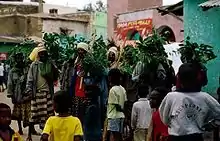

Rainmaking is a weather modification ritual that attempts to invoke rain.
Among the best known examples of weather modification rituals are North American rain dances, historically performed by many Native American tribes, particularly in the Southwestern United States. Some of these weather modification rituals are still implemented today.[1]
Examples
North America

Julia M. Buttree (the wife of Ernest Thompson Seton) describes the rain dance of the Zuni, along with other Native American dances, in her book The Rhythm of the Redman.[2][3] Feathers and turquoise, or other blue items, are worn during the ceremony to symbolize wind and rain respectively. Details on how best to perform the Rain Dance have been passed down by oral tradition.[4] In an early sort of meteorology, Native Americans in the midwestern parts of the modern United States often tracked and followed known weather patterns while offering to perform a rain dance for settlers in return for trade items. This is best documented among the Osage and Quapaw Indian tribes of Missouri and Arkansas.[5]
In April 2011, Texas governor Rick Perry called the Days of Prayer for Rain in the State of Texas, asking that Texans pray for "the healing of our land [Texas]" and for an end to the drought.[6][7]
In the Ozarks, multiple methods of attempting to call rain have been documented:
Other hillmen try to produce rain by burning brush along the creeks, or hanging dead snakes belly-up on fences, or killing frogs and leaving them in the dry road, or putting salt on gravel bars, or suspending live turtles above the water. [..] In some localities people imagine that they can cause a rain by submerging a cat in sulphur water—they don’t drown the animal, but make sure that it is completely under water for a moment at least. I once saw this tried at Noel, Missouri, but without any success.[8]
Africa
Rain is a central concern of African societies which depend on it for their sustenance and that of their animals. The power to make rain is usually attributed to African kings. In a number of African societies, kings who failed to produce the expected rain ran the risk of being blamed as scapegoats and killed by their people.[9] A famous rain making monarch is the Rain Queen of Balobedu, South Africa.
Tribal rain dances are done to ensure rain comes. Notable peoples known to have done rain dances are tribes on the Sahara Desert and Ethiopia.
North Africa
_06.jpg.webp)
China
Wu Shamans in ancient China performed sacrificial rain dance ceremonies in times of drought. Wu anciently served as intermediaries with nature spirits believed to control rainfall and flooding.[10] "Shamans had to carry out an exhausting dance within a ring of fire until, sweating profusely, the falling drops of perspirations produced the desired rain."[11]
Europe
Roman religion had a ceremony called the aquaelicium (Latin: "calling the waters") which sought to produce rain in times of drought.[12] During the ceremony, the pontifices had the lapis manalis ("Water-flowing stone". Festus[13] distinguishes it from another lapis manalis, "stone of the Manes") brought from its usual resting place, the Temple of Mars in Clivo near the Porta Capena, into the Senate. Offerings were made to Jupiter petitioning for rain, and water was ceremonially poured over the stone.[14]
Caloian, Dodola and Perperuna, among other terms, refer to a family of Slavic and Romanian rainmaking rituals, some of which survived into the 20th century.
See also
References
- ↑ "Rain Dance". Indians.org. American Indian Heritage Foundation. Retrieved 4 September 2011.
- ↑ Julia M. Buttree (Julia M. Seton) The Rhythm of the Redman: in Song, Dance and Decoration. New York, A.S. Barnes, 1930.
- ↑ "Rain Dance of Zuni". Inquiry.net. 3 July 2013. Retrieved 5 March 2014.
- ↑ "The rain dance helped native Americans get through dry summers". Indians.org. Retrieved 5 March 2014.
- ↑ Guyette, R.P.; Spetich, M.A. (July 2003). "Fire history of oak–pine forests in the Lower Boston Mountains, Arkansas, USA". Forest Ecology and Management. 180 (1–3): 463–474. doi:10.1016/s0378-1127(02)00613-8. ISSN 0378-1127.
- ↑ Perry, Rick (21 April 2011). "Gov. Perry Issues Proclamation for Days of Prayer for Rain in Texas". Office of the Governor. Archived from the original on 11 January 2015. Retrieved 23 January 2018.
- ↑ Leonard, Andrew (21 April 2011). "The Texas climate change solution: God". Salon. Retrieved 22 April 2011.
- ↑ Randolph, Vance (2012). Ozark Magic and Folklore. Dover Publications. ISBN 978-1-306-33958-2. OCLC 868269974.
- ↑ Simonse, Simon. 1992. Kings of Disaster: Dualism, Centralism and the Scapegoat King in Southeastern Sudan. Brill. Lw
- ↑ Schafer, Edward H. 1951. "Ritual Exposure in Ancient China", Harvard Journal of Asiatic Studies 14:130-184.
- ↑ Unschuld, Paul U. 1985. Medicine in China: A History of Ideas. University of California Press. pp 33–34.
- ↑ Sir James Frazer, The Golden Bough ch. 5, "Magical Control of the Weather" (Abridged edition, MacMillan, 1922)
- ↑ Sextus Pompeius Festus, De verborum significatione, sub. tit. manalis (Latin and French text)
- ↑ Cyril Bailey, The Religion of Ancient Rome, ch. 2 (Archibald, Constable & Co., London, 1907)
External links
- Dragon Festival for rainmaking in Nio, Japan Archived 26 May 2015 at the Wayback Machine NHK (video)
- The Long Strange Journey of Earth's Traveling Microbes (2011). Fred Pearce. Yale Environment 360.